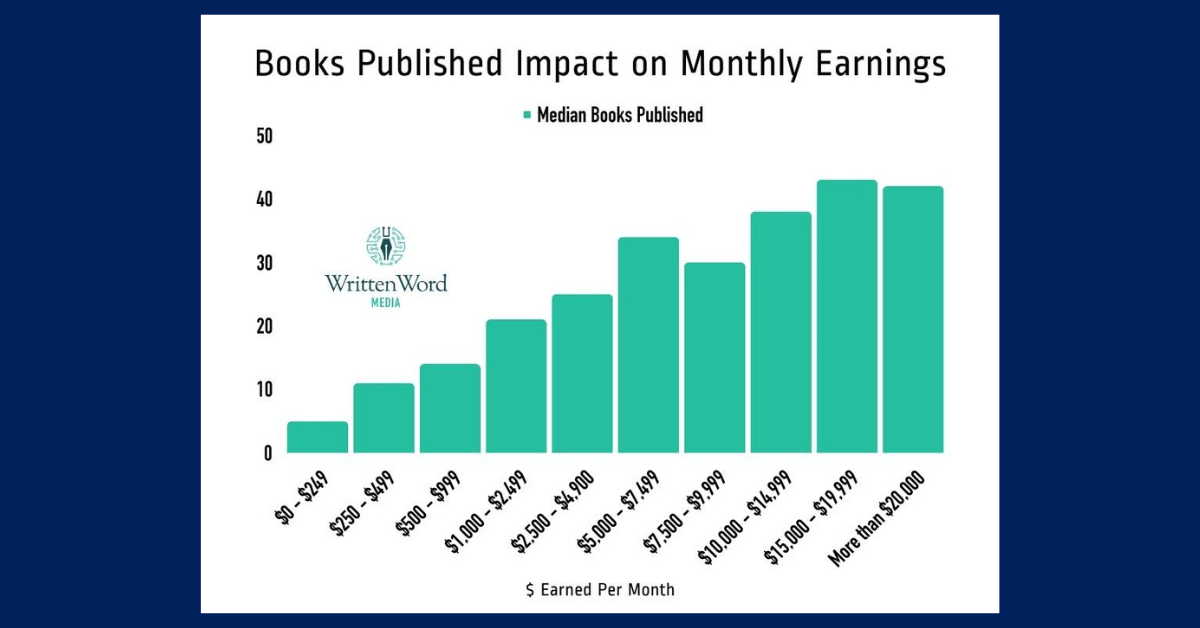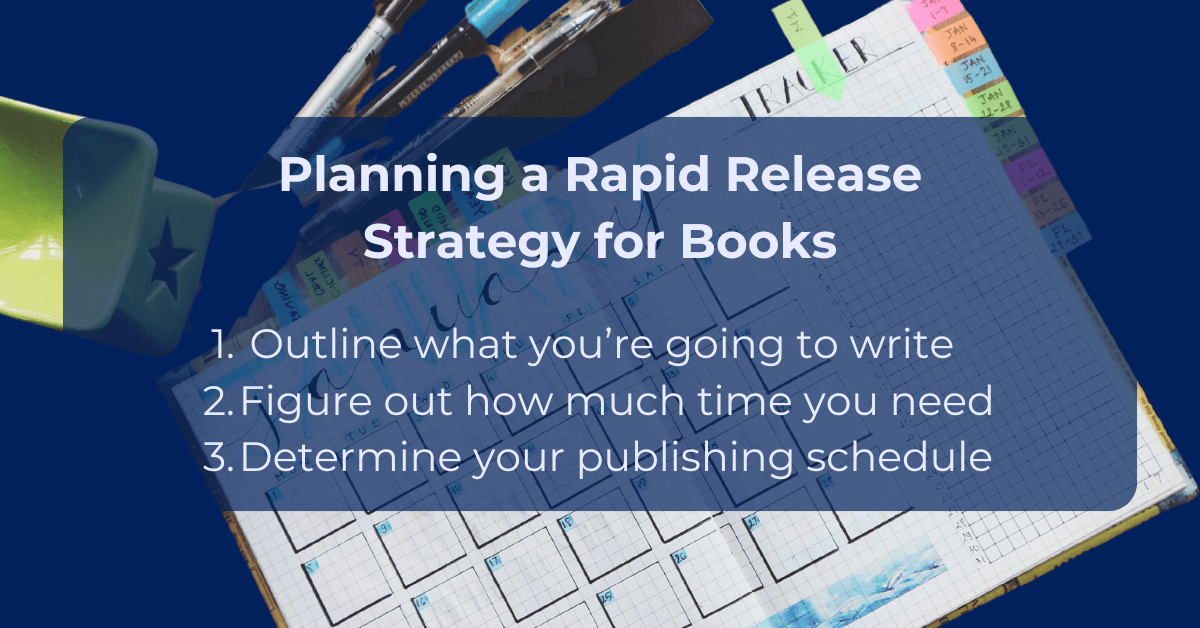How to: Rapid Release Strategy for Books

A rapid release strategy for books is an established best practice for self-publishing indies. To help you determine if the tactic is right for you, let’s go over everything you need to know.
This guide covers:
Main takeaway: A rapid release strategy entails releasing books quickly, one after another. Combined with solid book marketing, this type of publishing schedule aims to maintain reader attention, feed into digital algorithms, and generate more book sales with an ever-growing catalog of content.
What Is a Rapid Release Strategy for Books?
A rapid release strategy entails releasing books quickly, one after another. By following a speedy and continuous publishing schedule, indies can prolong reader attention from one book to the next. By providing more books that readers can choose from, you can work on building a fanbase of readers – crucial for a long-lasting career in publishing.
There are various ways to approach a rapid release strategy:
- Write consistently and quickly between releases
- Write several books upfront before executing a rapid release schedule
- Divide a large novel into shorter books to be released as a series
- Start with a series or universe in mind
When it comes to how often you should publish:
- Some indies release books just weeks apart
- Some indies release books in 30-day increments
- Some indies release books as long as three months apart
- Generally, this tactic pushes for a new release under 90 days
One of the goals of a rapid release strategy for books is to keep readers engaged, especially those who tend to binge content. That’s why longer series perform well under this system, along with genres like crime, romance, fantasy, and other popular fiction.
What Are the Benefits of a Rapid Release Strategy for Self-Published Authors?
As mentioned, fiction genres are well suited for rapid release. So, if you’re a fiction writer, this practice can be super advantageous. Once you’ve got someone to read one of your books, they are more inclined to check out the rest of your catalog. Particularly with series, readers want to know what’s next. There are other benefits as well (even for non-fiction writers.)
Benefits to know:
- With a shorter release time, readers won’t forget about your series.
- With a larger novel, you can divide it into multiple titles and create more buzz with a longer promotion schedule.
- You can stay on the minds of readers as you continuously promote your back-to-back releases at events, social media, and other spaces.
- As you hype each release, the rest of your catalog gains exposure as well.
- Amazon’s algorithms like newer releases. There’s a section on Amazon’s search filter for recently released titles.
- Amazon and other platforms also favor consistent releases with better visibility. You can increase your chances of landing in sections like “recommended for you” and “also-bought.”
- Building an extensive collection of books boosts your credibility and author brand.
Ultimately, a rapid release strategy for books is about making more sales. Written Word Media’s 2023 survey reported that authors could increase their earning potential with more books:

“If you have five published titles and sell them each for $3.99, a reader can really only spend $20 on your books. After that, they have no other way to support you. If you have 30 titles available for $3.99, the maximum a reader can spend on your books increases to $120. Just like that, the value of your superfans has increased 5x . . .
But, it’s not only the number of books. We can see in the graphs that the growth in published books is not linear. Once authors are making over $5,000/month from their book sales, the median number of published titles increases less steadily.”
Is a Rapid Release Strategy in Publishing Right for You?
We can see the advantages of a rapid release strategy for self-published authors. We can also see how much energy such a robust system requires. Is rapid releasing books for you?
Some questions to ask yourself:
- Do you have the time to write a series or many books at once?
- Do you have the time to write a book in 90 days, from one release to the next?
- Will you sacrifice the quality of your writing by working under a deadline?
- Can you invest in support, such as professional editors, book formatting services, designers, or marketing specialists?
A rapid release strategy for indies is best suited for:
- Writers who are producing regularly and consistently.
- Those who work well in a fast-paced dynamic with shorter deadlines and set schedules.
- Experienced authors with an established audience and solid marketing channels.
Not everyone writes at the same speed, has the same resources, or has the time to spare. A rapid publishing system will involve not just rapid writing, but rapid production and marketing. If you’re unsure about this route, that’s completely valid. If you’re feeling quite comfy so far, excellent!
Let’s talk about how you can plan a rapid release strategy for books –
How to Plan a Rapid Release Strategy for Self-Published Books

If you’re a newbie and never published a book before, make sure to learn about the self-publishing journey. Here’s a simple guide on how to get a book published. Do read up on how to create a book marketing plan as well. Everything you do as an author or publisher should align with your rapid timeline – from writing to marketing and beyond
1. Outline what you’re going to write
As mentioned already, a series is fantastic for rapid release. If not a traditional series that follows the same characters and storylines, you can try a series with characters loosely connected in an expanded universe. Also, don’t forget that if you already have a ton of content written, you can divide them into multiple books.
Figure out what you want to create and outline each book. You don’t have to get to the nitty-gritty. However, flesh out an overall plot arc with your main ideas for each title.
2. Figure out how much time you need to write everything
After deciding what to write, figure out how much time you need to complete your manuscripts. If you’re familiar with how many words you can write in a day or session, use that to gauge a realistic timeline. If you’re unsure, start timing yourself whenever you write to get your average word count.
Let’s say you plan on writing four books in a series. If each book is 70,000K words and your average writing count is 5K words a day, you can finish one book in about 14 days. Give yourself an extra cushion for editing days or sick days. All in all, let’s set your goal to writing one book in one month.
3. Determine your publishing schedule
Let’s continue with the example above. After knowing how much time you need to write your titles, consider production and marketing prep time. Your entire schedule to release a 4-part book series may look something like this:
- Jan: Write book #1
- Feb: Produce book #1 and prep marketing plan
- March: Release book #1 and promote
- April: Write book #2 (while continuing to promote book #1)
- May: Produce book #2 and prep marketing plan
- June: Release book #2 and promote
- Repeat the above until you hit book #4 by the end of the year
Or, maybe you want to write all four books upfront:
- Jan to April: Write all four books
- May to July: Produce books and prep marketing plan
- August to December: Release one book per month and promote throughout
As you can see, you can set your schedule however you like. Just consider your writing period, production period, promotion prepping period, and personal life period (you’re a human, not a machine!)
Whenever you get started on this amazing feat, stay flexible and give yourself enough space to move things around. Life happens.
Other Tips on Using a Rapid Release Strategy for Indies
Let’s end with other tips and best practices when implementing your rapid release strategy for self-published books:
- Get ahead of schedule. As a rule of thumb, you want to get ahead of schedule to give yourself the time needed for any life things that may (and usually) occur. For example, upload your files early so you can make final adjustments or fix any technical issues.
- Treat this work like it’s a business. As an indie, you’re your own boss. Get organized, keep up to date with industry trends, and run your self-publishing business as an authorpreneur.
- Set up pre-orders. Implement a pre-order strategy to build buzz as you move through your rapid schedule. Plus, since stores count sales on the day of release, running pre-orders is a great way to increase your chances of landing on bestseller lists on launch day.
- Prioritize your marketing plan. Do invest your time and budget into your promotions. If you have to take more time to prep your marketing plan and launch later, that’s better than releasing your book with a marketing plan you’re not 100% confident in. Creating and publishing your title is the first half of the work. You need to promote to make those sales.
- Use tools and resources. Whether it’s using AI writing software for authors or listening to self-publishing podcasts, harness the many tools and resources available. You can also join writers’ groups online to get connected with a community of other indies.
- Try co-writing to share the workload. You can also co-write a book to share the workload, cross-promote, and grow your catalog. Be sure to use a royalty software for publishers to easily manage co-royalties.
Last but not least, consider using a self-publishing platform like PublishDrive to help cut the administrative time it takes to publish your book in numerous retailers around the globe. With such an ambitious rapid release strategy, you don’t have to do this alone. ⬇
Need Help With Your Rapid Release Strategy for Books?
Watch how PublishDrive can help you manage distribution, royalty reporting, marketing, and much more:
✅ Publish ebooks, audiobooks, and prints
✅ Reach the largest network of bookstores
✅ Access publishing tools from formatting to marketing and beyond
✅Publish your 1st ebook free!